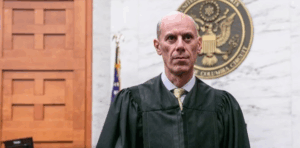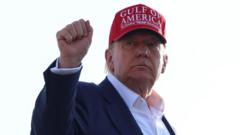Amid the ongoing legal battles associated with immigration enforcement, Judge Boasberg's ruling to potentially hold members of the Trump administration in criminal contempt has ignited a fierce debate about judicial authority and executive power.
Judicial Contempt Ruling against Trump Officials Sparks Political Firestorm

Judicial Contempt Ruling against Trump Officials Sparks Political Firestorm
Controversial ruling leads to accusations of judicial overreach from Trump allies while voices from the left see it as accountability for rule of law.
In a significant ruling, Judge James Boasberg has established “probable cause” to potentially impose criminal contempt on Trump administration officials related to immigration enforcement actions, as reported by multiple sources. This decision has elicited starkly polarized reactions along political lines.
The focus of this controversy centers around the administration's attempts to deport illegal migrants, including those considered national security threats. Despite a 5-4 decision from the Supreme Court affirming President Trump's authority under the Alien Enemies Act, Judge Boasberg asserts that the administration violated a temporary lower court injunction.
In response, White House officials adamantly reject the ruling, labeling it "legally baseless" and politically charged. A senior official was quoted asserting that "President Trump has been crystal clear—no judge will stop him from protecting the American people." This statement reflects the administration's broader narrative of judicial overreach and political bias.
Conversely, critics of the Trump administration view the ruling as a necessary check on executive power, expressing concerns over the potential misuse of authority in immigration enforcement. Legal expert Tom Fitton highlighted, “The Constitution gives the President control over foreign affairs and border security,” pointing out what he perceives as an ongoing judicial challenge to the Trump Administration's policies.
As the legal situation develops, opinions diverge sharply: supporters of Trump perceive the contempt ruling as evidence of a system threatened by a vigorous enforcement of the law, while opponents argue it is a crucial moment in affirming judicial independence.
Regardless of the perspectives, one conclusion resonates through this charged political landscape—Trump and his supporters remain unyielding, suggesting a future filled with continued conflicts between the executive branch and judicial interpretations.
The focus of this controversy centers around the administration's attempts to deport illegal migrants, including those considered national security threats. Despite a 5-4 decision from the Supreme Court affirming President Trump's authority under the Alien Enemies Act, Judge Boasberg asserts that the administration violated a temporary lower court injunction.
In response, White House officials adamantly reject the ruling, labeling it "legally baseless" and politically charged. A senior official was quoted asserting that "President Trump has been crystal clear—no judge will stop him from protecting the American people." This statement reflects the administration's broader narrative of judicial overreach and political bias.
Conversely, critics of the Trump administration view the ruling as a necessary check on executive power, expressing concerns over the potential misuse of authority in immigration enforcement. Legal expert Tom Fitton highlighted, “The Constitution gives the President control over foreign affairs and border security,” pointing out what he perceives as an ongoing judicial challenge to the Trump Administration's policies.
As the legal situation develops, opinions diverge sharply: supporters of Trump perceive the contempt ruling as evidence of a system threatened by a vigorous enforcement of the law, while opponents argue it is a crucial moment in affirming judicial independence.
Regardless of the perspectives, one conclusion resonates through this charged political landscape—Trump and his supporters remain unyielding, suggesting a future filled with continued conflicts between the executive branch and judicial interpretations.


















